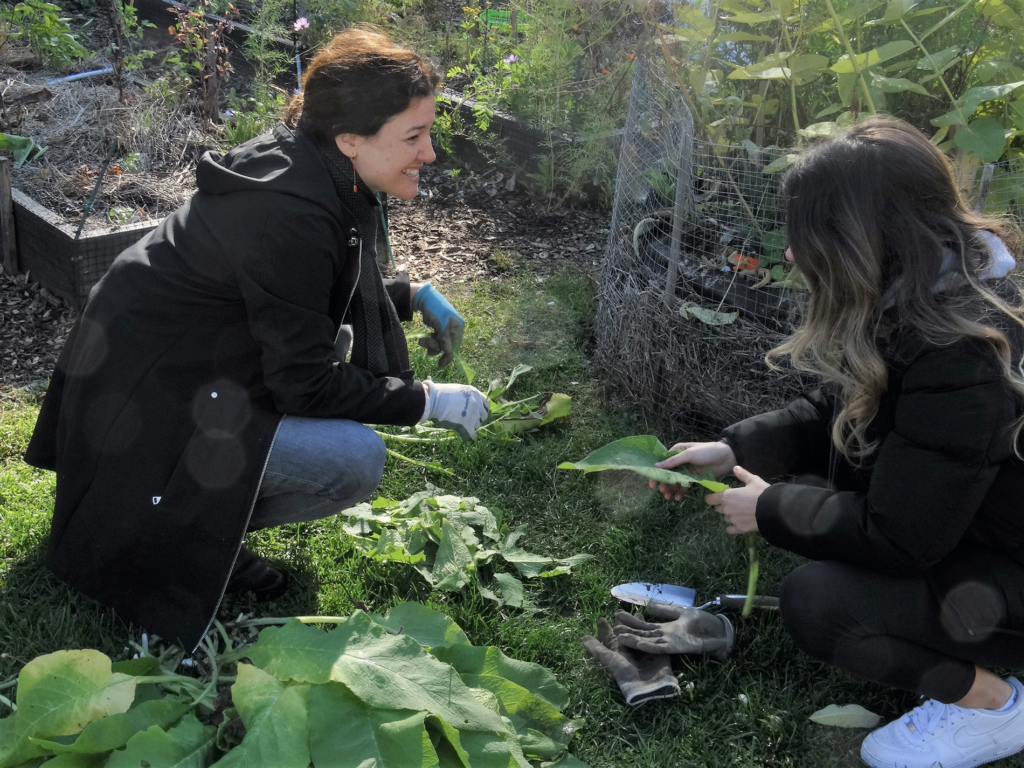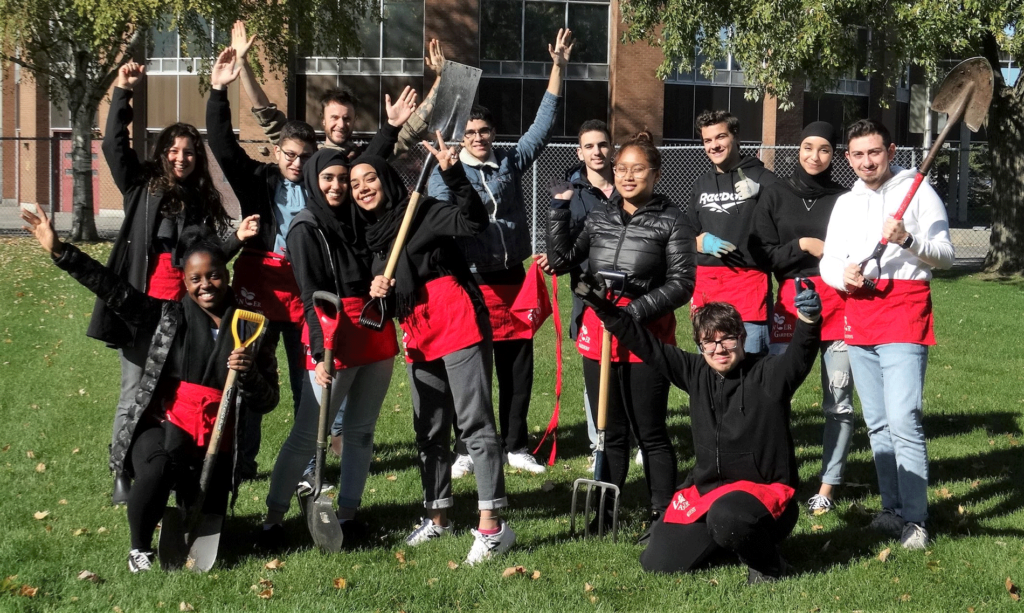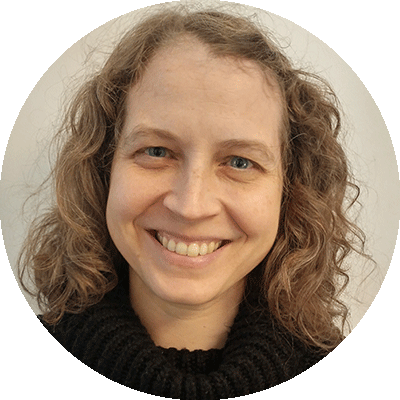Introduction
A sense of belonging plays an important role in students’ well-being and academic and educational success, and participation in community gardens promotes a sense of belonging, self-confidence, and mental health, according to a number of sources. In March 2017, pedagogical counsellor Krista Riley, on her own behalf and that of three Vanier teachers (Myriam Mansour, Kim Matthews, and myself), submitted an application for Entente Canada-Québec funding for a project that would focus on the Vanier Collective Gardens as a potential place to cultivate (pun only partly intended!) a sense of belonging in students who might otherwise feel marginalized at Vanier, through the use of garden-related activities, workshops and outreach. At the end of the Vanier Collective Gardens Community (VCGC) Project, we felt that work in this area had just begun. We hope the Vanier community as a whole will continue to reflect on the potential of the Gardens as a hub of learning and of belonging.
Definitions of Belonging
What is “belonging”? According to Vanier English teacher Alan Wong (2019), belonging is a basic human need to feel “respected, valued, accepted and cared for” that includes a sense of being “connected…to others in a social environment” (slide 5). College students can experience “not-belonging” if they, among other things: feel out of place in an academic environment; are minoritized (racialized, for example) and thus subject to prejudice; or are unable to fully participate in college life (due to personal, medical or other issues.) Belonging is not the same as inclusion: inclusion requires the will of another person or group (“we will include you”), whereas belonging is internal to the subject: a student’s feeling of belonging is their own, whereas if they are to be included, others are responsible for that inclusion. Wong also draws a distinction between belonging and fitting in: in order to fit in, one must adapt and conform to the environment, whereas, if one belongs, one belongs just as one is.
What conditions are necessary to create a sense of belonging in students? Rebeiro (Diamant & Waterhouse, 2010) suggests four conditions that can create an environment in which a sense of belonging can emerge: affirmation, an element of choice and self-determination, access to both private and community space, and a sense of safety (p. 85). Diamant and Waterhouse further point out the importance of facilitating these factors: where they do not emerge naturally, they must be actively fostered (p. 86).
The activities that we undertook in the course of the VCGC Project could all be seen to promote one or more of these conditions.
Affirmation
Some aspects of gardening at Vanier that existed before our project began were inherently affirming. For example, garden volunteers receive STAR volunteer hours that can lead to an attestation. Also, according to Diamant and Waterhouse (2010), such routine garden activities as weeding “[provide] instant feedback and a sense of achievement when the target area has been weeded” (p. 87). Also, “Gardening as a group…generates affirmation on multiple levels…from the group and the wider community, who are able to enjoy the output of their endeavours.” (Diamant & Waterhouse, p. 87)
The VCGC Project undertook a number of new activities that could be seen as providing opportunities for affirmation. A foundational part of our mission was the development of a Social Justice Statement (SJS) that would affirm the value of students of all backgrounds and identities. According to the SJS, the Gardens collective
focuses on uniting individuals and recognizing diversity, while promoting sustainability, mental health, and body positivity. We stand firmly against all forms of discrimination and we are working on creating a safe place where every Vanier student can feel they belong just as they are. We also aim to increase awareness of social justice topics such as food accessibility, gender equality, LGBTQ+ rights, and environmental issues, and to give our community the ability to discuss and share ideas. We are committed to an ongoing process of learning and self-reflection where we face our mistakes with a desire to grow and do better.
The intent of the statement is to make clear that the Gardens are a place where everyone matters and is treated with respect, and that we are all responsible for the dynamic, active process of making these things possible.
Important Note
All parties involved in the Gardens have found it important to acknowledge the traditional custodians of the land on which we do our gardening. Vanier is situated within the traditional unceded lands of the Kanien’kehá:ka (Mohawk) peoples, part of the Haudenosaunee Confederacy. There is also a strong historic presence of Anishinaabe
peoples in what is now known as the Greater Montreal area. As we work towards incorporating social justice principles, we remain aware of our responsibilities in the face of the settler colonial history and present.
Also, workshops throughout the year were intended to give students both skills for personal empowerment and new ways of looking at themselves. Cooking workshops provided opportunities for students, faculty, staff and guests to make food together and learn about such topics as vegetarianism and Indigenous food. Workshops on medicinal herbs and edible insects aimed to provide students with new ways of seeing food; others on permaculture, plasticulture, and seed saving empowered them to engage in sustainable practices; and a workshop on mental health and herbs was in part a way to normalize discussions about mental health. A workshop on body positivity and Health at Every Size was intended to promote the concept that all bodies are worthy of respect, regardless of their size.
The VCGC Project also collaborated with the food justice initiative A Place at the Table, initiated by humanities teacher and VCGC Project member Kim Matthews, in offering workshops, and, thanks to a generous contribution from Jake’s Café, free soup to all during six Universal Breaks throughout the semester. The active message was: you deserve soup no matter who you are! Also, thanks to the generosity of The Vanier College Foundation and The Vanier College Students’ Association, sixty-nine students in need received 100$ gift cards for Jake’s Café. The initiative’s goals were 1. to raise awareness of food security issues on campus, 2. to garner funds to provide food for students in need, and 3. to promote the building of students’ life skills. At the base of these goals was the affirmation of every student’s right to be fed. Soup was also served at workshops, and students were free to visit and take soup regardless of whether they participated in the workshop. The message was fundamental to our mission and to the mission of A Place at the Table: you do not need to pay in any sense, including with your time, to be worthy of having your basic needs met. This initiative was also an example of the importance of choice and self-determination in our desire to promote a sense of belonging in students.

Choice and Self-determination
Before the VCGC Project began, the Gardens were already providing students with opportunities to exercise their autonomy in a variety of ways. For example, student volunteers were asked to sign up for gardening activities that interested them – weeding, watering, planting, harvesting, maintenance etc. – at times that were convenient for them, and to make use of the Garden facilities, such as the shed and the tools it houses, whenever they wished.
Last year, as the VCGC Project was getting off the ground, we invited students to a brainstorming session to give their input as to what role the Gardens could play in their college experience and what sorts of infrastructure and activities they would like to see. We also hired two student interns, and chose them based partly on our stated requirement that they be self-motivated and able to work autonomously to organize outings, self-direct their work and tasks, and implicate other students.
As mentioned above, A Place at the Table also offered free soup at workshops while making it clear that students who were served soup were under no obligation to stay. A number of students availed themselves of the free meal and returned to their activities, although some decided to stay and participate in workshops; the choice was left up to them, and those who expressed a sense of guilt about taking free food and running were reassured that the soup had no strings attached!
The Gardens are a place where everyone matters and is treated with respect, and that we are all responsible for the dynamic, active process of making these things possible.
What activities could be undertaken in the future that might provide for choice and self-determination? Diamant and Waterhouse (2010) mention the importance of “encouraging responsibility for certain areas of the garden and planning the daily schedule” (p. 86). Asking students to assign themselves to specific garden areas might be possible if there were more volunteers available. (An earlier initiative entitled “Adopt-a-Box” allowed people from across the Vanier community to do just this; it was not implemented during the year of the VCGC Project, but could be again.) Encouraging teachers to allow students to do garden-related assignments might be a way to foster garden-related choice and self-determination in the context of students’ programs. Also, polling classes and clubs to ask for their input into Garden decisions (such as what they would like to see grown) might inspire students to come out and see and contribute to the Gardens.
Private and Community Space
The Gardens are already a community space, well-placed around and in the centre of campus, and accessible to everyone. One of the major achievements of the VCGC Project was the construction of a pergola as a space where clubs and individuals, as well as classes, can meet. The Project had a number of plans for this pergola, including setting up a signup system and reaching out to clubs and departments to encourage use of this space; unfortunately, construction delays meant that the Project was over when the pergola was finally erected. There are ongoing challenges concerning the maintenance and administration of this community space, but we hope the net outcome is positive: a public garden structure open to all students and available particularly for Garden Team activities. (I can personally attest to the success of bringing a class to the garden for a tour and lesson with the lead gardener, Mark Reynolds, and making use of the pergola to sit, discuss, have tea, take notes, and so forth.)
Private space is a different matter. In their discussion of a UK-based garden project, Diamant and Waterhouse (2010) outline some ways to create private space in a public garden context:
Although Thrive’s gardens are open to the public, there are areas that allow a person to be on his or her own, such as secluded areas or greenhouses…. Although access to [the general garden area] is open, the buildings used are off limits to the general public. These also act as private and confidential spaces. By providing these boundaries, Thrive has its own internal sense of community as well as being situated in the wider context of a public park. (p. 87)
The Collective Gardens are not technically a public area, but they are open to the entire Vanier community. One question that came up a few times during this project was the possibility of creating a Garden Club; if such a club were established, a Garden clubhouse for members could be an interesting benefit, and would create a private space for those who “belong” to the club. Also worth investigating would be the landscaping of parts of the Gardens to create nooks that create a sense of privacy, complete with benches and tables, although such concerns as accessibility, safety, and burdens on groundskeepers would of course have to be taken into account.

Safe Environment
The VCGC Project took several steps to create a sense of safety, particularly emotional safety, in the Gardens. In addition to the development of the Social Justice Statement, which articulates the collective’s mission to make sure everyone is respected, our hiring of two student interns was in part an effort to make students feel comfortable in a way they might not with staff and faculty. Our hope was that these students would put others at ease, both by “taking charge” and by liaising with faculty/staff mentors if there were difficulties. We hired an outside consultant (Mark Reynolds, mentioned above, who was later hired on to be lead gardener) to assist students and VCGC Project members with the organization of workshops, in order to give an additional sense of structure and authority that we hoped would relieve pressure for the student interns.
When it came to workshops, we tried to create a comfortable and collaborative atmosphere (including providing the free soup, inviting students in from the hallways, and reaching out directly to students who had participated in earlier workshops in order to make them feel welcome). By happenstance, we needed to change the date of our final workshop from the usual Universal Break workshop time to a slot during class hours, so we reached out to teachers, two of whom brought their classes to the workshop. This more structured approach alleviated the need for shy students to take on a new activity of their own volition. If given our time back, we might decide to schedule workshops during class hours more often.
In fact, reaching students where they are, rather than expecting them to come to us, was a continual preoccupation. Late in the year, we decided to try video-recording some of our workshops, but not all presenters were comfortable with this request; in the end, only the final workshop (“Breaking the Rules Around Food”) was recorded and shared on our website. However, we did collaborate with VTV for a special segment for the “Campus Cooking” channel, in which Brandee Diner, an Environmental and Wildlife Management teacher, and her student Sophie McCafferty presented information about Garden activities and demonstrated how to make tofu rice bowls with produce from the Gardens. The hope was that first encountering information about the Gardens on video would be less emotionally risky for shy students, and might give them the impetus to take the step to come out to a workshop or to volunteer.
Regardless, creating a collective and physical space that gives students a sense of comfort and safety is something that could be worked on in the future. More publicization of the Social Justice Statement and overall social justice mission, especially to other college groups and bodies, might be a start. Also, more presence and hands-on involvement of faculty/staff mentors —not just garden coordinators but organizers of activities, especially during the summer—might give students a greater sense of structure and support. This is difficult because most garden activity takes place during periods when teachers are not available to the college, and because creating a sense of safety and comfort for students requires a particular set of interpersonal skills. One easier step would be to organize workshops during times when teachers can bring classes, in order to minimize students’ emotional risk-taking in making the choice to attend.
Conclusion
Our objective of creating a space of “belonging and learning” in the Gardens is a long-term one. One important consideration is that there is very little garden work that can happen during the academic year; it might make sense for other projects and services to come together with the Gardens to create a larger cross-campus initiative under the umbrella topic of student belonging. We feel that the Gardens can provide a hub that makes students feel they can “come as they are” and find a place for themselves, but it is a goal that the Gardens can achieve only with the support of the entire community. We are confident that Vanier has the will and means to provide this support, and we look forward to seeing the ways that the Gardens are a part of this larger achievement in the years to come.

Dana Bath
is a teacher in the English department.
Works Cited
Diamant, E. & Waterhouse, A. (2010). Gardening and belonging: reflections on how social and therapeutic horticulture may facilitate health, wellbeing and inclusion. British Journal of Occupational Therapy, 23(2), 84-88. https://pdfs.semanticscholar.org/3433/3b3941f44c7e65bf85aa98e0bb8af34a8a61.pdf
Riley, K. (2017). ECQ project proposal: Jardins d’échanges : espaces d’appartenance et d’apprentissage.
Vanier College Collective Gardens. (2019). Social justice statement. Retrieved from https://www.vaniercollege.qc.ca/collective-gardens/about-us/#justice
Wong, A. (2019). To be(long) or not to be(long): why a student’s sense of belonging matters at Vanier. [PowerPoint slides].


